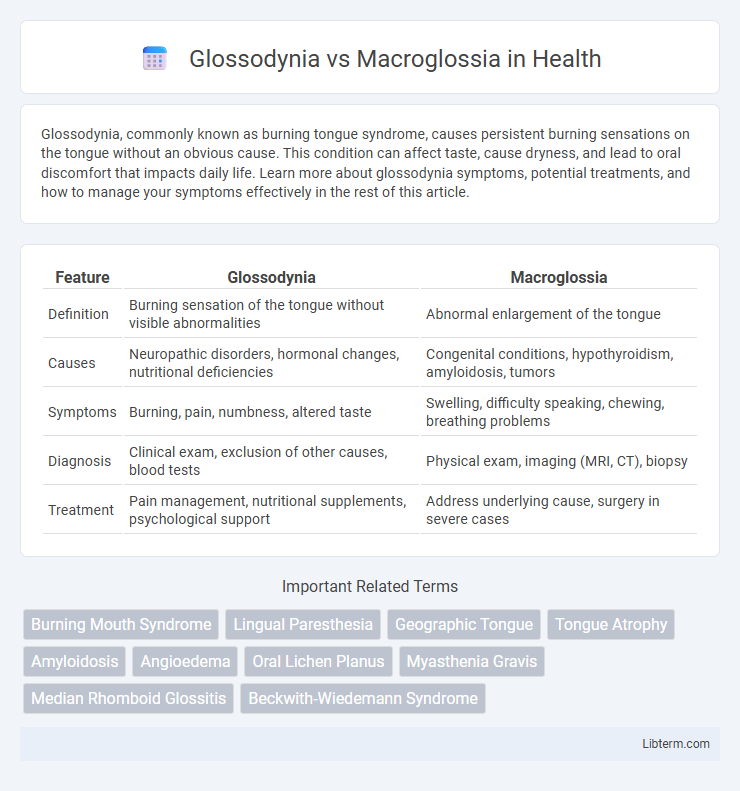Glossodynia, commonly known as burning tongue syndrome, causes persistent burning sensations on the tongue without an obvious cause. This condition can affect taste, cause dryness, and lead to oral discomfort that impacts daily life. Learn more about glossodynia symptoms, potential treatments, and how to manage your symptoms effectively in the rest of this article.
Table of Comparison
| Feature | Glossodynia | Macroglossia |
|---|---|---|
| Definition | Burning sensation of the tongue without visible abnormalities | Abnormal enlargement of the tongue |
| Causes | Neuropathic disorders, hormonal changes, nutritional deficiencies | Congenital conditions, hypothyroidism, amyloidosis, tumors |
| Symptoms | Burning, pain, numbness, altered taste | Swelling, difficulty speaking, chewing, breathing problems |
| Diagnosis | Clinical exam, exclusion of other causes, blood tests | Physical exam, imaging (MRI, CT), biopsy |
| Treatment | Pain management, nutritional supplements, psychological support | Address underlying cause, surgery in severe cases |
Understanding Glossodynia: Definition and Symptoms
Glossodynia, also known as burning mouth syndrome, is characterized by a chronic burning sensation on the tongue without visible signs of irritation. Symptoms include persistent tongue pain, dryness, altered taste, and a tingling or numbness that can affect eating and speaking. Unlike macroglossia, which involves an actual enlargement of the tongue, glossodynia primarily involves neuropathic pain without anatomical changes.
What Is Macroglossia? Key Characteristics
Macroglossia is a medical condition characterized by an abnormally enlarged tongue, which can cause difficulties in speaking, chewing, swallowing, and breathing. Key characteristics include tongue protrusion beyond the teeth, indentations on the tongue's edges from pressure against the teeth, and potential airway obstruction in severe cases. Unlike glossodynia, which involves tongue pain or burning without size change, macroglossia primarily involves physical enlargement that may result from genetic disorders, inflammatory conditions, or tumors.
Glossodynia vs Macroglossia: Essential Differences
Glossodynia, characterized by chronic tongue pain without visible lesions, differs fundamentally from macroglossia, which involves an abnormal enlargement of the tongue often due to underlying conditions like amyloidosis or hypothyroidism. Glossodynia primarily affects nerve sensation leading to burning or discomfort, whereas macroglossia physically alters tongue size and function, impacting speech and swallowing. Understanding these essential differences is crucial for accurate diagnosis and targeted treatment in oral pathology.
Common Causes of Glossodynia
Glossodynia, characterized by a burning sensation on the tongue without visible abnormalities, commonly arises from causes such as nutritional deficiencies (particularly vitamin B12, iron, and folate), hormonal changes like menopause, and psychological factors including anxiety and depression. In contrast, macroglossia involves an enlarged tongue often due to congenital conditions, infections, or systemic diseases like amyloidosis and hypothyroidism. Understanding the distinct etiologies of glossodynia helps guide targeted treatment and differentiate it from anatomical conditions like macroglossia.
Underlying Causes of Macroglossia
Macroglossia is primarily caused by underlying conditions such as congenital disorders like Down syndrome, muscular hypertrophy, or infiltrative diseases including amyloidosis and hypothyroidism. In contrast, glossodynia, characterized by a burning sensation on the tongue, is often linked to neuropathic factors, nutritional deficiencies, or psychological stress rather than anatomical enlargement. Understanding the etiology of macroglossia aids in distinguishing it from glossodynia and guides appropriate clinical management strategies.
Diagnostic Approaches for Glossodynia
Diagnostic approaches for glossodynia emphasize a thorough clinical examination, detailed patient history, and exclusion of systemic conditions such as diabetes or nutritional deficiencies. Blood tests evaluating vitamin B12, iron, and thyroid function are pivotal in identifying underlying causes, while pain assessment scales help quantify symptom severity. In contrast, macroglossia diagnosis primarily relies on physical measurement and imaging studies to detect abnormal tongue enlargement or associated structural anomalies.
Diagnostic Challenges in Macroglossia
Macroglossia presents significant diagnostic challenges due to its variable etiology, including congenital conditions, hormonal imbalances, and neoplastic causes, which require comprehensive clinical and imaging assessments. Differentiating macroglossia from Glossodynia is critical, as Glossodynia involves idiopathic tongue pain without visible enlargement, whereas macroglossia features true tongue hypertrophy. Accurate diagnosis involves biopsy, imaging studies like MRI or CT scans, and evaluating systemic diseases such as amyloidosis or hypothyroidism to guide effective management.
Treatment Strategies for Glossodynia
Treatment strategies for glossodynia primarily involve addressing underlying causes such as nutritional deficiencies, hormonal imbalances, or psychological factors like stress and anxiety. Topical anesthetics, corticosteroids, and analgesics are commonly prescribed to alleviate pain and discomfort associated with burning mouth syndrome symptoms. Cognitive-behavioral therapy and oral hygiene improvements also play a significant role in managing glossodynia effectively compared to macroglossia, which often requires surgical intervention to reduce tongue size.
Management and Therapy for Macroglossia
Management of macroglossia involves addressing the underlying cause, such as treating hypothyroidism or managing amyloidosis, to reduce tongue enlargement. Surgical intervention, including partial glossectomy, is often necessary for severe cases to improve airway patency, speech, and mastication. Supportive therapies like speech therapy and orthodontic treatment may enhance functional outcomes following surgical management.
Prognosis and Quality of Life: Glossodynia vs Macroglossia
Glossodynia, characterized by chronic burning pain on the tongue without visible lesions, often results in persistent discomfort that can significantly impair taste perception and oral function, negatively impacting quality of life despite a generally benign prognosis. Macroglossia, marked by an enlarged tongue due to systemic conditions like amyloidosis or hypothyroidism, may cause speech difficulties, airway obstruction, and dental problems, with prognosis depending on underlying disease management and severity. Effective treatment of glossodynia focuses on symptom control to improve daily functioning, while managing macroglossia requires addressing the root cause to prevent complications and optimize patient outcomes.
Glossodynia Infographic

 libterm.com
libterm.com